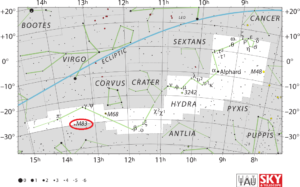Messier 83 or M83, also known as the Southern Pinwheel Galaxy and NGC 5236, is a barred spiral galaxy approximately 15 million light-years away in the constellation borders of Hydra and Centaurus.
| Description | |
| Visible From Pacific Northwest | March To May |
| Best Time To Observe | May |
| Minimum Size Of Viewing Device | 10 x 50 Binoculars |
| Object Type | Barred Spiral Galaxy |
| Designations | Messier 83, M83, NGC 5236, Southern Pinwheel Galaxy, PGC 48082, UGCA 366, 2E 3112, 2E 1334.2-2936, ESO 444-81, IRAS 13341-2936, 2MASX J13370091-2951567, MCG-05-32-050, MRC 1334-296, MSH 13-2-05, PKS 1334-296, RBS 1293, RX J1337.0-2952, SPB 225 |
| Right Ascension | 13h 37m 00.9s |
| Declination | -29°51’57” |
| Constellation | Hyrda |
| Number Of Stars | 40 Billion |
| Apparent magnitude | +7.54 |
| Apparent dimensions | 12′.9 x 11′.5 |
| Object Radius | 27,500 light years |
| Distance From Earth | 15.21 Million light years |
History
The Southern Pinwheel Galaxy was discovered by the French astronomer Nicolas Louis de Lacaille on February 23, 1752 at the Cape of Good Hope in South Africa. Lacaille catalogued the object as Lacaille I.6. and described it as a “small nebula, shapeless.”
Charles Messier included the object in his catalogue on February 17, 1781.
English astronomer William Lassell noted the object’s spiral structure and sketched it, describing it as a “three-branched spiral.”
John Herschel catalogued M83 as h 3523 and later added it to the General Catalogue as GC 3606.
Locating M83 In The Sky
Located 30 degrees south of the celestial equator, Messier 83 is the southernmost galaxy listed in Messier’s catalogue, which makes it one of the most difficult Messier objects for northern observers because it never rises very high above the southern horizon.
The galaxy lies near the border with Centaurus constellation, about three quarters of the way from the bright star Spica (mag. +1.04) in Virgo to Menkent (mag. +2.06) in Centaurus. It can also be found using the stars Gamma or Pi Hydrae. The galaxy is located 6.5 degrees south and 3.15 degrees east of Gamma (mag. +2.99) and 3.15 degrees south and 6.20 degrees west of Pi Hydrae (mag. 3.25). The best time of year to observe M83 is during the spring.

Viewing M83
M83 is one of the nearest and brightest barred spirals in the sky and can be seen in 10×50 binoculars, which only reveal a patch of light with a brighter core. 3-inch telescopes show a larger patch of nebulosity with a bright centre, while 6-inch telescopes begin to hint at the bar structure and the dark patches around the galaxy’s central region. 10-inch telescopes reveal the galaxy’s well defined spiral structure, dark dust lanes and the central bar.
Photographing M83
The issue with Messier 83 is going to be low on the horizon which makes imaging very difficult, as the thick atmosphere causes seeing effects that tend to wash out the fine details. Therefore, things such as clouds or precipitation in the atmosphere can turn out to ruin imaging of Messier 83. Being so low requires multiple nights of data acquisitions to get enough data. Modified DSLRs will help as will CMOS will improve the image capturing as will accurate autoguiding. Filters will also help draw out the colors. There are a plethora of great cloudy nights and astrobin options for finding similar setups. Due to the beautiful view, M83 is a popular target/
https://www.cloudynights.com/topic/577602-m83-the-southern-pinwheel-galaxy/
Sources And Further Reading
Descriptions of all of Messier Objects can be found here.
https://www.messier.seds.org/m/m083.html
https://www.nasa.gov/feature/goddard/2017/messier-83-the-southern-pinwheel

Be the first to comment on "Messier 83 Southern Pinwheel Galaxy"